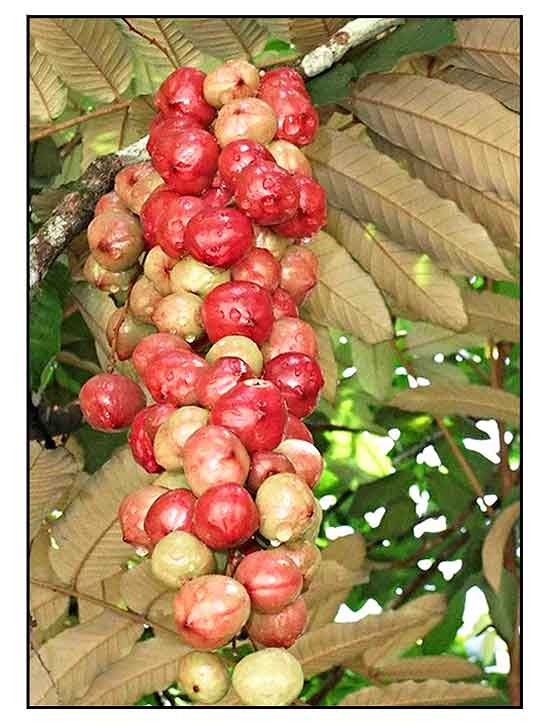 Gen info Gen info
- Aglaia is a genus of 121 recognized species of woody deciduous trees in the mahogany family Meliaceae. Some are important timber trees; others with scented flowers and medicinal properties.
Botany
• Tree up to 15 m, with a rounded crown. Outer bark smooth, grayish-brown with some lenticels in longitudinal rows; inner bark brown or pale brown; sapwood pale yellow or pale brown, sometimes tinged with pink; latex white. Leaves imparipinnate, at least up to 135 cm long and 50 cm wide; petiole up to 25 cm long, petiole, rachis and petiolules with scales like the twigs. Inflorescence up to 40 cm long and 28 cm wide, peduncle up to 10 cm, peduncle, rachis and branches with surface and indumentum like the twigs. Flowers sessile, up to 2 mm in diam. Petals 5. Staminal tube sometimes shallowly cup-shaped with the rim incurved, usually ellipsoid with the aperture up to 0.5 mm in diam. and obscurely 5-lobed; anthers almost as long as the tube, ovoid, inserted near the bottom of the tube, usually included but sometimes protruding through the pore. Fruits up to 3 cm long, 2.2 cm wide, ellipsoid or subglobose, grey or brown; pericarp thin, densely covered with reddish-brown stellate scales or peltate scales which have a fimbriate margin on the outside, containing white latex; locules 1–3, each containing 1 seed. Seed with a thin aril; the aril white, pale yellow or pink. (Flora Malesiana) (2)
Distribution
- Native to the Philippines. (1)
- Also native to Jawa, Laos, Malaya, Maluku, Sulawesi, Sumatera, Thailand, Vietnam. (1)
Constituents
- Study of bark of Aglaia eximia isolated four antioxidant compounds, kaempferol (1), kaempferol-3-O-α-L-rhamnoside (2), kaempferol-3-O-ß-D-glucoside (3) and kaempferol-3-O-ß-D-glucosyl-(1-->4)-α-L-rhamnoside(4). (see study below) (4)
- Study of stem bark isolated a new stigmastane steroid, 3,4-epoxy-(22R,25)-tetrahydrofuran-stigmast-5-en (1), along with two known triterpenoids (2-3) and two known steroids (4-5). (see study below) (5)
- Study of methanol extract of bark isolated a new (-)-5',6-dimethoxyisolariciresinol
-(3",4"-dimethoxy)- 3α-O-ß-D-glucopyranoside. (6)
- A dammarane tritepene, 3α,20(S)-dihy-droxy-dammar-24-ene, which crystallized out in a hydrated form, C(30)H(52)O(2).1.075H(2)O, was isolated from the Aglaia eximia bark. (8)
Properties
- Studies have suggested antioxidant, cytotoxicity, anti-leukemic, aromatase inhibitory, anticancer properties.
Parts used
Stem bark, leaves.
Uses
Edibility
- Aril reportedly edible when taken in moderation. (2)
Folkloric
- No reported folkloric medicinal use in the Philippines.
- In Indonesia, used for reducing fever, moisturizing the lungs, treatment of contused wound, coughs, and skin diseases. (4)
- In Indonesia, used for treatment of malaria.
Studies
• Antioxidant / Bark: Study of bark of Aglaia eximia isolated four antioxidant compounds, kaempferol (1), kaempferol-3-O-α-L-rhamnoside (2), kaempferol-3-O-ß-D-glucoside (3) and kaempferol-3-O-ß-D-glucosyl-(1-->4)-α-L-rhamnoside(4). All compounds showed DPPH radical scavenging activity with IC50s of 1.18, 6.34, 8.17, and 10.63 µg/mL, respectively. (4)
• Cytotoxicity / P-388 Murine Leukemia Cell Lines / Stem Bark: Study of stem bark isolated a new stigmastane steroid, 3,4-epoxy-(22R,25)-tetrahydrofuran-stigmast-5-en (1), along with two known triterpenoids (2-3) and two known steroids (4-5). Compounds 1-5 showed weak-moderate cytotoxicity against P-388 murine leukemia cells with IC50s of 11.42, 4.26, 29.10, 45.96, and 52.09 µg/mL, respectively. (5)
• Anticancer and Cytotoxic Potential / Leaves: Study evaluated the cytotoxic potential and anticancer mechanism of cycloart-24-ene-3ß,26-diol isolated from leaves through bioassay-guided fractionation. In vitro assays were conducted against two cancer cell lines—hormone dependent breast adenocarcinoma cels (MCF-7) and homone-independent breast adenocarcinoma cells (MDA-MB-231). Results showed cycloart-24-ene-3ß,26-diol is cytotoxic to MCF-7 and MDA-MD-231 in a dose- and tiime-dependent manner, with no significant effect on viability of normal mammary cells. Flow cytometry analysis of annexin V/;propidium iodide (PI) dual staining showed cell death through apoptosis. Cell cycle analysis showed cycloart-24-ene-3ß,26-diol caused G1-S phase arrest in MCF-7. Cycloart-24-ene-3ß,26-diol also inhibited CYP19 (aromatase), suggesting potential aromatase inhibition. Results suggest potential of leaves for development into a chemopreventive agent for breast cancer. (7)
Availability
- Wild-crafted.
|

![]()




